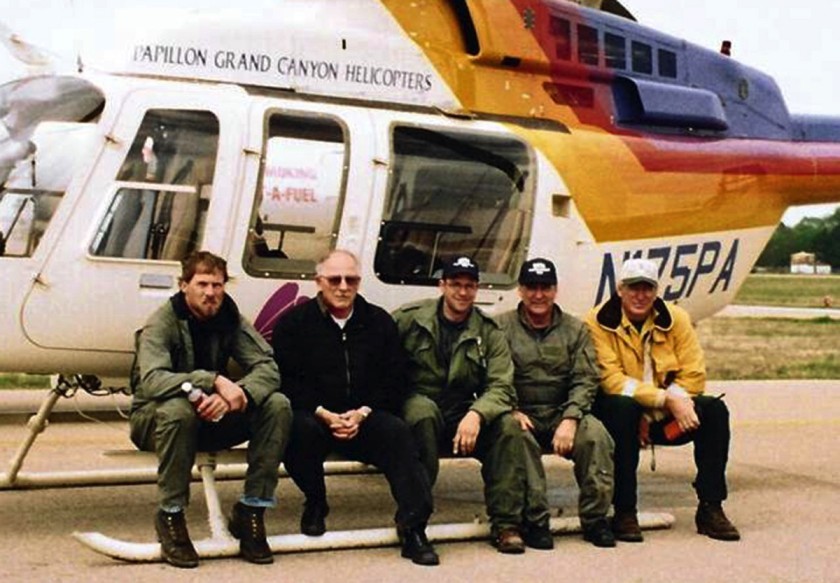In East Texas, people make sure you are aware that nine people lost their lives as a result of the Columbia accident—the seven astronauts and two searchers.
Supplementing the massive ground search for Columbia‘s debris was an aerial search of the area on several miles on each side of the ground search corridor. The Texas Forest Service managed more than thirty contracted helicopters that were operating in the air over East Texas every day.
Pilots flew just above treetop level, as spotters searched for debris on the ground. The spotters generally included representatives from the Texas Forest Service, the US Forest Service, and NASA or its contractor United Space Alliance (USA).
The air searches were not without risk. Flying just above the treetops, there was often little room for a pilot to make an emergency landing if something went wrong. Makeshift power lines cropped up in strange places in the rural areas, posing hazards to air crews who attempted to land to pick up debris.
On the afternoon March 27, 2003, luck ran out for one of the air search crews. Pilot Jules “Buzz” Mier was flying his Bell 407 helicopter over the Angelina National Forest that day, accompanied by Charles Krenek of the Texas Forest Service in the front seat. In the rear of the helicopter were Matt Tschacher of the US Forest Service, Richard Lange from USA, and Ronnie Dale from NASA’s Safety and Process Assurance Branch at Kennedy Space Center.
Mier was an Army Vietnam veteran with thousands of hours of flight experience. He had a business operating air tours in the Grand Canyon. When he heard that the country needed experienced pilots for the Columbia search, he answered the call to service.
Krenek was a resident of Lufkin, Texas. He had twenty-six years of experience as an aviation specialist and a woodland firefighter. He was well-known and well-liked throughout East Texas.

After a stop for lunch and refueling, Mier and his crew took off at 3:15 on Thursday, March 27 for their second search mission of the day. About an hour into the flight, the engine suddenly quit. Mier, flying just above the treetops over Ayish Bayou, had no options for autorotating to a safe landing. The helicopter crashed nose-first into the crown of an oak tree and plummeted to the ground. Mier and Krenek were killed instantly when the cockpit was crushed. The three men in the rear seat were all badly injured, but they all survived.
Local resident William Dickerson and his nephew were fishing in the area when they heard the helicopter go down. They helped the injured men from the helicopter and to the nearest road, and then went to call for help. US Forest Service law enforcement officer Doug Hamilton and Sabine County Sheriff Tom Maddox were among the first responders. After wading back through the swampy area to the crash site, they realized they could not bring out the bodies and Mier and Krenek without assistance.
Felix Holmes and Marsha Cooper of the US Forest Service brought a bulldozer and several all-terrain vehicles to the site. Holmes knocked down pine trees with his dozer to create a makeshift path for the ATVs.
East Texas was in shock after the accident, losing a “favorite son” in the search for Columbia. Despite the grief, no one voiced regrets or blame. Rather, the community regarded it as a sacrifice to an important undertaking. It proved that the people of East Texas were doing their utmost to help NASA return to flight, no matter the personal cost.
The motto that had been circulating since the early days of the recovery effort now seemed even more poignant. Their mission became our mission took on a much deeper meaning for the citizens of East Texas. They were now inextricably part of the Columbia story—their own blood mixed with the blood of NASA’s astronauts.
The crash caused an immediate stand-down in air searches while the NTSB and the participating agencies investigated the accident and reviewed search procedures. The cause was traced to a faulty fuel control unit. Search procedures were revised to improve safety and eliminate unnecessary risks. Searches would have to be from a higher altitude. There would be no more landing to pick up debris; searchers would call in GPS coordinates for ground teams to make recoveries. Finally, air operations would be concentrated farther west in the debris field, which as less heavily forested than the eastern portion.
Now that they had given the lives of one of their own men to the cause, it was more critical than ever to ensure that the task was worthwhile—that these two men and the crew of Columbia had not died in vain. And indeed, the air searches were very productive, eventually accounting for 65 percent of the shuttle debris that ended up on the grid in the reconstruction hangar. They helped solve the mystery of the accident.
[Please see this excellent article by Christopher Freeze for more technical information about the accident.]

Beautifully said account. Thank you
Sent from my iPhone
>
LikeLike